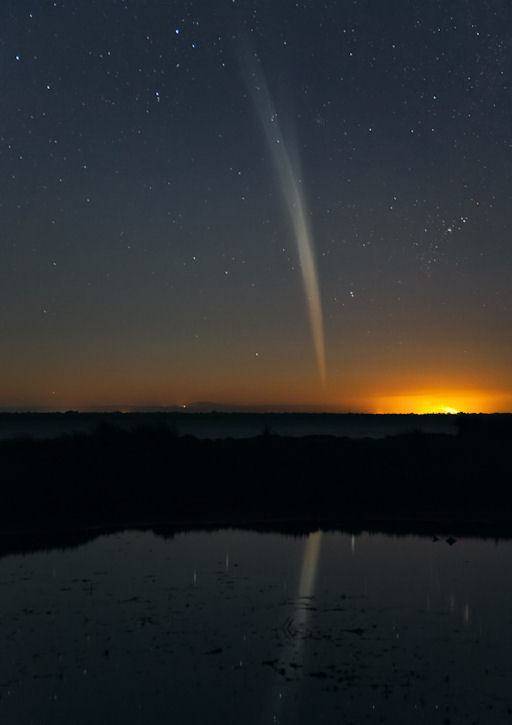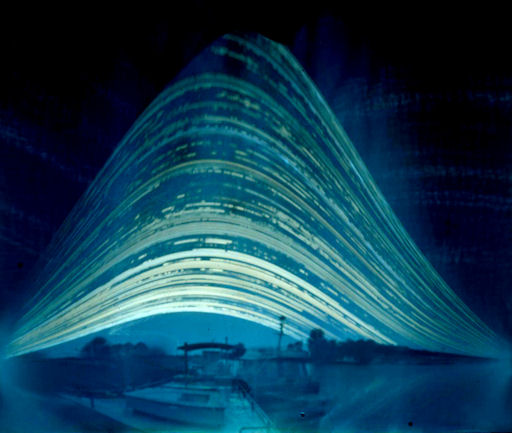Don't just watch shooting stars. Wear them! Authentic meteorite jewelry for Christmas is now available in the SpaceWeather Store. | | |
COMET LOVEJOY GETS EVEN BETTER: Sungrazing Comet Lovejoy is so bright that "it can now be seen with the unaided eye for more than an hour before sunrise," reports Colin Legg of Mandurah, Western Australia. This morning, a short exposure with Legg's digital camera was sufficient to reveal the comet's reflection in the waters of the Mandurah Estuary:

"It was an amazing sight," says Legg. Indeed, Lovejoy appears to be the finest comet since Comet McNaught in 2007.
Dawn sightings of Comet Lovejoy are now widespread around the Southern Hemisphere. (The tilt of the comet's orbit does not favor northern sightings.) Many observers are asking about the comet's "double tail." These are the dust and ion tails. The gaseous ion tail is blown almost directly away from the sun by the solar wind, while the heavier, brighter dust tail more closely follows the comet's orbit: diagram. The gap between the two tails can be seen with the naked eye while the sky is still pitch dark ~30 minutes before dawn.
The visibility of Comet Lovejoy should continue to improve in the days ahead as the comet moves farther away from the sun. Early-rising sky watchers in the southern hemisphere should be alert for this rare apparition. [finder chart]
more images: from Emilio Lepeley of Vicuna, Chile; from Rogerio Marcon of Campinas SP Brasil; from Stephen Chadwick of Himatangi Beach, New Zealand; from Kosma Coronaios of Louis Trichardt, Limpopo Province, South Africa; from Paulo Morales Valdebenito of San Francisco de Mostazal, Chile; from Willian Souza of Sao Paulo, Brazil; from Grahame Kelaher of Perth, Western Australia; from Minoru Yoneto of Queenstown, New Zealand;
THE SUN IN A BEER CAN: "I have captured the sun in an empty beer can," reports Jan Koeman of Kloetinge, the Netherlands. In June 2011, Koeman assembled a solargraph--a simple pinhole camera consisting of a beer can lined with photographic paper--and for the past six months he has used it to record the sun's daily motion across the Dutch sky. Today he removed the photo-paper for inspection:

"This is what a photo with an exposure time of nearly 6 months looks like," says Koeman. The highest arcs were traced by the summer sun of June 2011. The lowest arc was made just today, Dec. 21st, on the eve of the 2011 winter solstice. Occasional gaps are caused by clouds.
Curiously, Koeman had more than one empty beer can to work with on that hot summer day in June when he began his project, so there are multiple views to enjoy. Click here for more solargraphs.
6-month Solargraph How-to Guides: #1, #2, #3
Dec. 10th Total Lunar Eclipse Gallery
Potentially Hazardous Asteroids (
PHAs) are space rocks larger than approximately 100m that can come closer to Earth than 0.05 AU. None of the known PHAs is on a collision course with our planet, although astronomers are finding
new ones all the time.
On December 22, 2011 there were 1272 potentially hazardous asteroids.
Notes: LD means "Lunar Distance." 1 LD = 384,401 km, the distance between Earth and the Moon. 1 LD also equals 0.00256 AU. MAG is the visual magnitude of the asteroid on the date of closest approach. | | The official U.S. government space weather bureau |
| | The first place to look for information about sundogs, pillars, rainbows and related phenomena. |
| | Researchers call it a "Hubble for the sun." SDO is the most advanced solar observatory ever. |
| | 3D views of the sun from NASA's Solar and Terrestrial Relations Observatory |
| | Realtime and archival images of the Sun from SOHO. |
| | from the NOAA Space Environment Center |
| | the underlying science of space weather |

